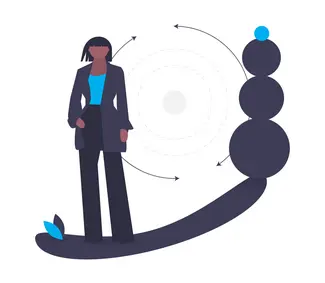Do you know someone who doesn’t like surprises or being told what to do? Those attitudes are prevalent among people who resist change at work and are shaped by several factors. Fortunately, resistance to change can be overcome.
This article shares approaches on how to overcome resistance to change and build enthusiasm for embracing the unknown. It likewise shows you how to use those principles to navigate a vendor switch to make the process smoother and less intimidating. Read on to learn how these methods work.

Why we resist change
Change is a constant in the workplace. Overcoming resistance to change is no longer just a nice-to-have; it’s become mission-critical to the success of businesses and the people who work in them. The first step to conquering this resistance is to understand why some people resist change.
Researchers have compiled a laundry list of reasons people avoid change, such as:
- Disturbed practices, habits, and relationships
- Lack of respect and trust in the people who promote change
- Self-interest and shifts in power and influence
- Dislike of imposed change
- Dislike of surprises
- Reluctance of management to deal with difficult issues
- Lack of self-confidence and confidence in others
Experts wrestle with the best way to effect change, but generally agree on one point: Adopting change is the only way to thrive in a digitally-driven business world that evolves rapidly.

How to step into change
Moving people from their ‘comfort zone’ means moving from the familiar, secure, and controllable, to the unfamiliar, insecure, and uncontrollable.
Here are four mindset shifts to help anyone warm up to the idea of change.
- Embrace the opportunity: Ultimately, if you don’t focus on the change, you won’t be successful. Maintaining a positive outlook and focusing on the change that is ahead will keep you from falling backwards.
- Be curious: Ask yourself, “How is this moment happening for me rather than to me.” Ask good questions and follow your curiosity. This will give you confidence to navigate what lies ahead.
- Accelerate your goals: Resisting change will slow you down from reaching your destination. Change presets you with the opportunity to go further, faster.
- Lean on others: You’re in this together. Recognize that you are not the only one experiencing the change personally or professionally. Reaching out to those around you can make it easier to navigate change.

Manage the fear factor
Anxiety. Fear of uncertainty. Fear of failure. All of these keep us from stepping into change, but—good news—each of these factors can be modulated.
Motivational speaker Tony Robbins offers an excellent set of techniques for overcoming fear. We’ve summed several that can be used:
- Adopt a growth mindset
It’s not about achieving your goals and being perfect every step of the way. It’s about getting comfortable with what you don’t know and continuing anyway. As Robbins says, “No matter how many mistakes you make or how slow your progress, you’re still way ahead of everyone who isn’t trying.” - Recognize excuses
Fear makes you procrastinate. It’s much easier to make excuses than put in the long hours and energy needed to reach your goal. Recognize when you are using excuses and figure out how to overcome them. Replacing them with a positive approach is a good start. - Know that failure is part of the process
Everyone on the planet – including those you know and admire – has encountered failure. Realize that your fear of failure is preventing you from making the decision to achieve your objectives. - Visualize your goals
Goal visualization sets your focus. This visualization may take the form of priming, meditation, or imagery training. What’s important is to see yourself succeeding and condition yourself into believing that you can do whatever you imagine. - Keep company with success
People who are focused on overcoming fear and achieving their dreams surround themselves with others who share that mindset. This group may include people you admire as well as those who will push you in a positive direction.

Change and the art of switching vendors
Don’t go through change alone. Find a strategic partner.
Changing litigation support service providers can help law firm staff members solve work-related frustrations and operate more efficiently today. But what about the future? With workflow automation, data, and digital transformation trends taking hold in the legal industry, not all vendors are prepared to support modern law firms seeking assistance in these areas.
You can sidestep that problem if you know how to evaluate whether your vendor has the stuff to be a strategic partner.
“Strategic” means the firm and the vendor can do more together than individually. A strategic partner has deep industry knowledge to know what else can be done with synergies created by systems and technologies beyond an obvious product feature.

How do I evaluate a vendor?
If you are considering switching vendors, don’t be sold on technology alone. The truth is technology by itself does not make a 21st century law firm.
The vendor you want should bring strategy and new ways of thinking to the table, as well as best-in-class technology.
An example of that may be found in how a vendor thinks about integrations or data metrics with the law firm.
If a vendor gives a law firm visibility and transparency into the litigation support service work itself, and shows the firm what more can be done to gain efficiency and cost savings on the execution of work the vendor does, that means the relationship is strategic.
A strategic partner will help uncover and examine a firm’s vision, strategies, and plans.
Firms that have the most data and insights will win
In the 21st century, change for the better means switching to a tech solution that produces data. That data should tell you how well your business is running. Furthermore, the data must be sharable and timely so you can use it to track performance and identify trends.
The ability to help you use data smartly is the mark of a strategic partner.

What kind of data can I use?
If you’re considering a switch, a new vendor should provide data associated with common litigation support services such as court filing, eFiling, and process serving. This data can help gauge the performance of vendors and function as a cost control measure.
Yes, it works
As an example, a firm can examine service of process orders by pricing zone to predict whether the cost of service of process in certain locales may be untenable. The firm may also use the reports to gauge a law firm’s internal performance and whether the vendor is delivering service as promised.
Other firms are using vendors that have this capability which means it’s no longer a nice-to-have but rather, mission critical.
Set expectations
A big part of what a firm can achieve depends on the providers they select to help them get the job done. But what is the job, exactly, and how should it be done?
Good leaders answer these questions by setting expectations for their firms and their vendors. They make sure those expectations are clearly defined by answering the following:
- What are the expectations?
- Can the vendor meet them?
- Have the expectations been clearly articulated?

The relationship you need and want
Some relationships continue long after their expiration date. That may be the case oftentimes between law firms and vendors. The law firm continues to do business with a poor-performing vendor simply because they believe changing vendors will require too much fuss and bother.
But that thinking is a good way to ensure you never get what you deserve or need.
If the aim of your vendor switch is to create a truly positive effect on your law firm, take a moment to think about whether your current litigation support service vendor offers:
- Transparency
- A dedicated account manager
- Data reporting that identifies good/poor performance
- Tying more strategic implementations into other systems
- Metrics that confirm cost savings
Even a good relationship should not stand in the way of a switch to something that helps the law firm operate at a higher level.
Make sure your partner is consultative. Find one that has deep industry knowledge it will share to reveal to you what else can be done to bring efficiencies, cost savings, and risk mitigation.

Change is good
Embracing change is a critical skill for your personal and professional life. Throw out the idea that change is hard and get your transformation moving with a change in mindset. Then, tap into your curiosity, peer network, and technology vendors to help reinvent yourself.
Remember, stepping into change will not only expand your knowledge and inspire your co-workers, but it will also make you stand out as a law firm and create competitive advantage.
Schedule a call or book a demo today with a Rapid Legal account executive today to find out how we can be a strategic partner and help you navigate change successfully.
